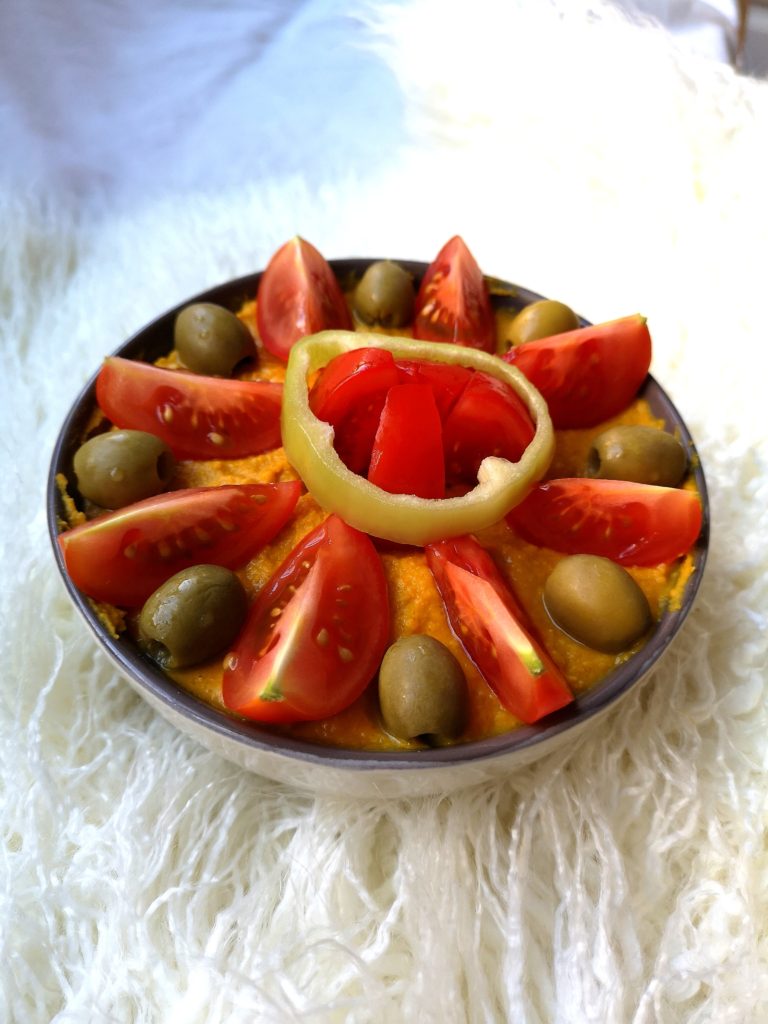This is the most delicious and quickest dish you can make for breakfast, lunch or dinner, or even just as a snack and will be the best part of your picnic.
Hummus is something everybody loves. (Or at least, I don’t know anyone who doesn’t). Of course the easiest way would be to buy it at a store, but aren’t they way overpriced? Not to mention the many additional unnecessary and unhealthy ingredients.
I always get a load of chickpeas, tahini and olives from the Turkish Deli, and they are not only delicious and extra large portions, but very cheap, too! You won’t find anything healthier than a home made hummus, plus you season it with anything your heart (or taste buds) desires.

Ingredients:
1 can chickpea (300g)
juice of 1 lemon
1 ts sea salt
3-4 tbs tahini
1 clove garlic
a dash of ground black pepper
1 tsp of harissa paste
(optional)
1 tbs olive oil
1 heaped tsp of cumin powder
1 ts turmeric powder
The recipe, as usual, is super easy: Put all the ingredients in a blender until you get a smooth cream. If it’s not creamy enough, you can add some of the aquafaba (chickpea water) until you get the desired consistency.
To make different versions: add extra ingredients, such as curry powder, chili, olives, paprika powder, pumpkin puree, cumin seeds or garlic. Last time I tried with spinach and green onions, and both turned out amazing.
I avoid the pita bread, for the gluten, but you can have it with that. I just eat it with gluten free bread slices or cracker corn bread.
Hummus ayurvedic qualities and energetics
Traditionally hummus is based on chickpeas which we know are hard to digest so we need to add some spices! The second important ingredient of hummus is sesame paste (tahini). Sesame seeds are sattvic in nature and Vata decreasing. And that is the beauty of hummus: because we add sesame paste, plenty of spices and oil it is much easier to digest the chickpeas. So from an ayurvedic perspective hummus makes total sense!
Chickpeas
Chickpeas, as all beans, are Vata increasing, Pitta and Kapha decreasing. Their rasa (taste) is sweet and aftertaste (Vipaka) is pungent. The energetics of chickpeas (virya) is cooling. Chickpeas are a great source of iron, calcium and potassium and Vitamin A.
Tahini
Tahini is sesame paste. Sesame seeds (til) are sweet (rasa), Vata decreasing, Pitta and Kapha increasing. Sesame seeds are a sattvic food. So more goodness to add to the hummus!
Garlic
Garlic is a medicinal food and regarded as tamasic in ayurveda. That doesn’t mean you shouldn’t have it! It helps (among many other benefits) with gas and indigestion so here it is good to add garlic.
Too much garlic can cause Pitta imbalances and mental dullness (which is why it is usually avoided in yogic circles but as with all foods it has its time and place).
Garlic (Rasonam) literally means ‘lacking one taste’, meaning it has all of the 6 tastes except one: the sour taste is missing. It is mainly pungent in rasa and is pungent as well in vipaka. Garlic is Pitta increasing and Vata-Kapha decreasing.
Harissa
Harissa is a Moroccan style red bell pepper and chili paste with garlic, oil, caraway seeds and coriander. If you don’t have harissa in the house substitute with a mixture of chili and paprika powder. The reason I add it here is to have some ‘punch’ as we are going into spring and Kapha will be aggravating. If you have Pitta imbalances you can leave it out.
Turmeric powder
I add turmeric for its beautiful colour and health properties. Be sure to add black pepper as that is what will increase the bio-availability of the turmeric.
All these additions make that you can enjoy hummus every day if you want to. And be honest, who doesn’t??

